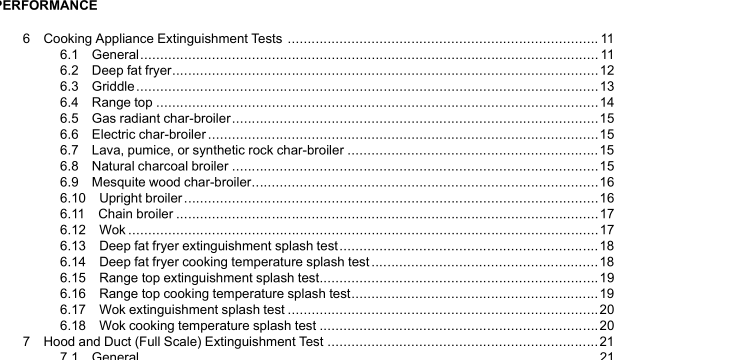UL 300-2019 pdf download.Fire Testing of Fire Extinguishing Systems for Protection of Commercial Cooking Equipment.
1 Scope 1.1 These requirements cover the performance during fire tests of pre-engineered fire extinguishing system units intended for the protection of commercial cooking equipment for restaurants, cafeterias and other similar venues. For installation requirements, see the following documents: NFPA 17, Standard for Dry Chemical Extinguishing Systems; NFPA 96, Standard for Ventilation Control and Fire Protection of Commercial Cooking Operations; NFPA 17A, Standard for Wet Chemical Extinguishing Systems; and the National Building Code of Canada. Note that local authorities having jurisdiction should be consulted prior to installation. 1.2 Pre-engineered fire extinguishing system units, agents, or both shall also comply with the requirements for construction and performance as applicable to specific types, designs, sizes, and arrangements. Such additional requirements include ANSI/CAN/UL/ULC 1254 and are not within the scope of these requirements for fire tests. 1.3 The term “product” as used in this standard refers to all fire extinguishing systems or any part thereof covered by the requirements unless specifically noted otherwise. 2 Components 2.1 Except as indicated in 2.2, a component of a product covered by this standard shall comply with the requirements for that component. 2.2 A component is not required to comply with a specific requirement that: a) Involves a feature or characteristic not required in the application of the component in the product covered by this standard, or b) Is superseded by a requirement in this standard. 2.3 A component shall be used in accordance with its rating established for the intended conditions of use.
5.3 CYLINDER/VALVE ASSEMBLY – A container that incorporates a valve and that provides storage of the extinguishing agent and expellant gas until the valve is actuated. For cartridge operated units, this assembly includes the extinguishing agent storage container and cartridge mechanism. When actuated, the valve releases the agent into the distribution network of the extinguishing system. 5.4 DISCHARGE RATE – The ratio of the quantity of agent discharged from a nozzle to the discharge time measured within ±1 s. When a minimum discharge rate is indicated, reference is made to the minimum quantity of agent discharged and the time measured within ±1 s. 5.5 DISCHARGE NOZZLE – A device that is used to uniformly distribute the extinguishing agent over or into a specific area. 5.6 DISCHARGE TIME – The time interval between the first appearance of extinguishing agent at the nozzle and the time at which the discharge becomes predominantly gaseous. 5.7 DUCT (OR DUCT SYSTEM) – A continuous enclosed passageway for the transmission of air and cooking vapors. 5.8 EXPELLANT GAS – Dry nitrogen, dry air, or other gas used to facilitate the discharge of the extinguishing agent. 5.9 EXTINGUISHING SYSTEM UNIT – Identified components that are assembled into a system for the discharge of an extinguishing agent through fixed piping and nozzles for the purpose of extinguishing fires. 5.10 GAS CARTRIDGE – A container that provides storage for an expellant gas. 5.11 GREASE – For test purposes, grease is new vegetable shortening incorporating an anti-foaming agent. For hood and duct and broiler testing only, grease shall be new or used vegetable shortening, or rendered animal fat.
5.17 OPERATING PRESSURE – The pressure in a fully charged container at 70°F (21°C). 5.18 PLENUM – The volume of enclosed space between the grease filters and the portion of the hood above the grease filters in a hood and duct system. 5.19 PRE-ENGINEERED SYSTEM – A system that is tested in accordance with the limitations prescribed by the manufacturer for maximum and minimum pipe lengths, accessories, number of fittings, number and types of nozzles and nozzle placement, types of fire risks and their maximum areas, volumes, or both areas and volumes of protection. 5.20 PRESSURE VESSEL (CYLINDER) – A container that provides storage for the extinguishing agent and expellant gas, or when used at a location remote to the extinguishing system unit, provides storage for expellant gas. 5.21 TILT SKILLETS/BRAISING PANS – Cooking devices which are intended to braise, simmer, saute, or fry foods. PERFORMANCE 6 Cooking Appliance Extinguishment Tests 6.1 General 6.1.1 An extinguishing system unit is to be tested with each type of cooking appliance with which it is intended to be used. Specific cooking appliance test methods are contained in 6.2 – 6.18. Exception: Protection fortilt skillets is to be based upon the coverage limitations provided fordeep fat fryer protection. 6.1.2 Except as provided in 6.1.14, the appliances used in testing shall meet the minimum requirements as described in the applicable subsections of Section 6.UL 300-2019 pdf download.
UL 300-2019 pdf download
